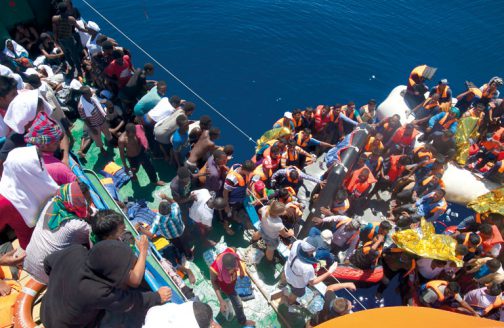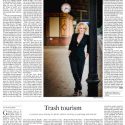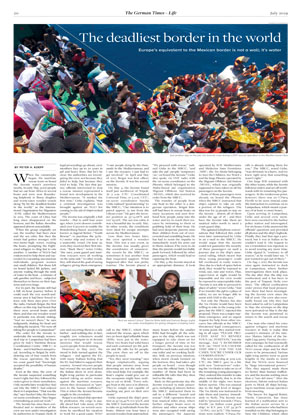The deadliest border in the world: Europe’s equivalent to the Mexican border is not a wall; it’s water

When the catastrophe began, the maritime rescue team on board the Iuventa wasn’t anywhere nearby. In early May, 3,000 people had set out from Africa in several boats and were now floundering helplessly in flimsy dinghies and worm-eaten wooden vessels along “by far the deadliest border in the world,” as the International Organization for Migration (IOM) called the Mediterranean in 2015. The coast of Libya had long since disappeared on the horizon, and the Italian shoreline appeared almost unreachable.
When the group originally set out, the weather had been clear and the sea calm. But then the winds had gotten stronger, with two-meter-high waves rocking the boats, prompting the frightened refugees to cling fast to one another. A number of NGOs had endeavored to help them and succeeded in evacuating unconscious individuals, pregnant women and small children. But those left on board lacked life jackets, and anyone wading through the stink of water in the boat – a mixture of salt, gasoline and feces – subjected themselves to burns on their legs, arms and even lungs.
For its part, the Iuventa still had a full six-hour journey before it could reach the very search-andrescue area it had been forced to leave only three days prior. Over the radio, Dariush Beigui, the first officer on this trip, had heard that there were several boats adrift there, and that one wooden vessel in particular was already sinking. “And we weren’t there,” he says indignantly, shaking his head and recalling the incident. “We were off taking five people to Lampedusa!”
The order for the Iuventa to undertake the seemingly nonsensical trip to Lampedusa had been given by Italy’s Maritime Rescue Coordination Centre (MRCC) in Rome – and it had been unequivocal. According to Beigui, by withdrawing one of four vessels from the rescue operation, the Italian coast guard had “knowingly accepted the possibility of human deaths.”
Even at the time, the crew of the Iuventa suspected something wasn’t right, but they followed the orders given to them nonetheless. Only months later would they find out why the MRCC had ordered them to Lampedusa. “That was the day,” says Sascha Girke, the former on-scene coordinator, “they began criminalizing us and our work.”
The Iuventa has since been confiscated and 10 members of the crew are now under investigation by authorities in Trapani, Sicily. If legal proceedings go ahead, crew members face up to 20 years in jail and heavy fines. But let’s be clear: the authorities are investigating the crew not because they failed to help, but because they tried to help. The fact that justice officials intervened to stop a rescue mission represented a brand new development in the Mediterranean. “It marked the first time,” Girke explains, “that a criminal investigation was brought against an NGO for coming to the aid of shipwrecked people.”
The Iuventa was originally a fish trawler – that is, until four years ago, when 2,000 donors contributed over €150,000 to enable the Brandenburg-based association known as Jugend Rettet (“Youth Rescue”) to purchase the 33-by- 6.7-meter ship and restore it as a seaworthy vessel. On June 25, 2016, they received their first mission. “Back then,” notes Girke, “the navy, coast guard and maritime rescuers were all working on the same side.” In other words, they still shared the goal of saving refugees, giving them emergency care and escorting them to a safe harbor – and nothing else. In fact, roughly 200 volunteers would go on to participate in 16 Iuventa missions that would rescue 14,000 people from drowning. However, in May 2017, the mood in Italy turned against the refugees – and against the EU, with many Italians feeling that the EU had failed to support their country. Around 160,000 people had crossed the sea and reached the Italian shore in 2016 alone. Right-wing parties in particular started taking an active stance against the maritime rescuers, whom they denounced as “partners to the human traffickers.” This is when the Iuventa became caught in the crosshairs.
Beigui is an inland ship operator by profession. His cargo is usually diesel fuel. Like many of his fellow rescuers, on several occasions he sacrificed his vacation to work for a good cause. Why? “I saw people dying by the thousands in the Mediterranean, and I saw the rescuers. I just had to get involved.” In April and May of 2017, Beigui was first officer on the Iuventa. It was his second mission.
On May 4, the Iuventa found itself just northwest of Tripoli. At 3 a.m. UTC (Coordinated Universal Time, or 5 a.m. CET), on-scene coordinator Sascha Girke radioed “good morning” to the MRCC. “Our intention is to patrol approx. 15 nm from the Libyan coast.” He gave the Iuventa’s position as 33°14.08’N and 012°25.19’E. The sea was calm; it was a beautiful day in early May. In other words, the conditions were ideal for escape attempts across the Mediterranean.
Less than two hours later, the crew spotted a wooden boat. This was a rare event, as the Iuventa was usually given the coordinates of unseaworthy vessels by the MRCC, or sometimes it was another boat that requested support. What happened after that was pretty routine: The Iuventa placed a call to the MRCC, which then ordered the rescue, upon which two 30-knot rigid inflatable boats (RIBs) were put in the water. These two boats had solid bases and each contained 150 life jackets and life rafts for 80 people. The crew then set off to the people in need.
“Yes, they need rescuing,” says Beigui emphatically, arguing that people minutes away from drowning are not the only ones who need help. For example, the boat’s engine could give out or the occupants might have nothing to eat or drink. “Every refugee boat in the area is in distress. They’re simply not capable of reaching any port on their own steam.” Girke reported the ship’s position as 33°03.49’N 012°502’E, and the MRCC instructed the Iuventa to take on 35 individuals from the boats. Almost one hour later, a second wooden boat approached. “We proceed with rescue,” radioed Girke to the MRCC, “and take the ppl [people] temporary [sic] on board the Iuventa.”
Girke also spoke via VHF radio with the on-scene coordinator on the Phoenix, which belonged to the Malta-based aid organization Migrant Offshore Aid Station (MOAS), which also received its order from the MRCC.
The transfer of people from one boat to the other is a dangerous operation. Beigui himself had been in rescue boats on many occasions and seen firsthand how people jump into the water and try to reach their rescuers by swimming to them or grabbing hold of their boat. He had seen desperate parents raise their children from out of overcrowded and crumbling boats. He has had to resist the impulse to immediately reach his arms out to them: indeed, if he were to do that, the parents would inevitably push forward, followed by other passengers, which would lead to capsizing the boat.
On May 4, the Iuventa stayed at an appropriate distance. It took many hours before the smaller RIBs had brought all the refugees to the ship, which was not equipped to take them on for a longer period of time or for transport; the Iuventa was too small for such tasks and only had one toilet and no cooking facilities. Still, on previous missions, when storm clouds loomed on the horizon, they had taken 480 people on board – even though 120 was the official limit. A large number of them had been in inflatable life rafts that they then tied to the ship.
Back on this particular day, the Iuventa rescued 75 male passengers, including 55 minors, before the MRCC instructed them to sail to a different “search and rescue” (SAR) operation three or four nautical miles away, where further refugee boats were in distress and other rescue ships were also occupied with saving the passengers: the Aquarius operated by SOS Méditerranée and Médecins Sans Frontières (MSF), the Vos Hestia belonging to Save the Children, Sea Watch 2 and the large Phoenix operated by the Migrant Offshore Aid Station (MOAS), which was originally supposed to have taken on all the passengers on the Iuventa.
Some of those passengers were already on board the Phoenix when the MRCC instructed that ship’s captain to take on only a portion of the refugees. The idea was for 25 people to stay on the Iuventa – almost all of them under the age of 18 – and then have the Iuventa take them 90 nautical miles north to meet a coast guard ship.
The agitated telephone conversations that followed this order were later summarized by Girke in an e-mail to the MRCC. He would argue that the Iuventa could not guarantee the security of these passengers on such a journey due to the ship’s unsecured railing, which meant that these young passengers could fall overboard in rocky waters. Also, due to a lack of space below deck, they would be exposed to wind, sun, rain and waves. Plus, supervision at night would be impossible and the crew would be exposed to unacceptable risks. “Iuventa is not able to proceed to place of safety” wrote Girke. “And if we transfer the ppl to a place of safety, we are no longer able to assist with SAR in the area.”
Not only the Phoenix, but also the Vos Heistia would have been willing to take in the young refugees, but the MRCC rejected this proposal. There was a major maritime emergency and an urgent request for help from other rescuers, but officials at the MRCC threatened legal consequences. At some point, they started writing in all caps: “PLEASE PROCEED ASAP TO RENDEZ VOUS [sic] POSITION,” was the message. And “I REMEMBER YOU [sic] THAT YOU CHOOSE THIS MRCC FOR THE SAR CASES. YOU’RE UNDER OUR COORDINATION.”
The next morning at 3:09 a.m. UTC, the MRCC gave in a bit, with new “instructions” ordering the Vos Hestia to take on 20 of the remaining young passengers. They ordered this transfer to take place immediately, that is, in the middle of the night, two hours before sunrise. This was unusual due to the high level of danger. The Vos Hestia was instructed to take them and journey immediately to Sicily. The Iuventa was told to “proceed towards CP904 Fiorillo [an Italian coast guard ship] in R/V psn. LAT 34°30’N – LONG. 012°30’E.” The instructions were explicit: “CP904 Fiorillo is already waiting there for you.” The MRCC, noted Girke, “was obviously in a hurry. And we knew right away that something wasn’t right.”
One large RIB remained with the other teams, while the Iuventa followed orders and set off northwards with its remaining five passengers. At the rendezvous point, however, there was no CP904 Fiorillo to be seen; instead came the instruction to continue on to Lampedusa, which meant a journey of at least 10 more hours.
Upon arriving in Lampedusa, Girke and several crew members were escorted to the harbor police station and interrogated. For six hours, Girke answered the officials’ questions and provided all photos and the ship’s logbook. Finally, they had him sign a protocol, but it was in Italian so he couldn’t read it. His request to see a translation was rejected, so to avoid wasting any more time, Girke signed it, “contrary to all reason,” as he would later say. “I just wanted to get out of there.”
On Aug. 1, 2017, the Iuventa was once again instructed to dock at Lampedusa, where further interrogations then took place. The day after that, the ship was confiscated, and it has been in the port of Trapani, Sicily, ever since. The official confiscation order proves that local prosecutors there had been investigating the Iuventa crew since the fall of 2016. The crew also eventually found out why they had been asked to sail to Lampedusa in May: the wiretaps on the ship were activated on May 6, the day the Iuventa was permitted to return to the search and rescue area.
One man who raised his voice against refugees and maritime rescuers in Italy is today that country’s minister of the interior: Matteo Salvini of the farright Lega party. During the election campaign, he had repeatedly called for the confiscation of all NGO rescue ships and for their crews to be prosecuted. Various right-wing parties went to great lengths in the media to insist that the NGOs were financed by “large international powers.” This, they argued, made them no better than human traffickers, and the Iuventa nothing more than a “taxi del mare.” After the elections, Salvini ordered Italian ports to block all ships belonging to maritime rescue operators from mooring.
The lawyer for Jugend Rettet, Nicola Canestrini, has since learned of a notification sent to the Italian secret service by a security contractor who had been installed on the ship belonging to Save the Children, which often collaborated with the Iuventa.
The man sent e-mails to Salvini as well as to Luigi di Maio from the populist Movimento 5 Stelle (M5S), in which he insisted that the rescue missions were no coincidence but rather a direct transfer of refugees, with the Iuventa as the last link in a chain of human trafficking. He claimed that the crew had communicated with smugglers via a WhatsApp group and said that they had even dragged an empty refugee boat back into Libyan waters and allowed smugglers to reuse it. In another instance, he argued, they had made it possible for a fisherman or smuggler to dismantle the boat engine and take it with him.
Girke denies these accusations. A report from the Forensic Architecture research group at Goldsmiths College at the University of London also exonerated the crew. Their research findings come to the conclusion that “the seizure of the Iuventa is emblematic of a new attempt by European authorities to stem the flow of migration across the Mediterranean.”
The individuals rescued on that day have not been questioned about these events. Canestrini has signaled his readiness to provide the PIN numbers and passwords of the confiscated phones, tablets and computers as soon as an independent expert is put in charge of evaluating the devices and their content.
Italian state prosecutors continue to defend the confiscation of the Iuventa as a “preventive measure” designed to thwart further “aid in illegal entry” into the country. Other maritime rescue ships have also been confiscated for months. In 2016 and 2017, there were 13 NGO ships operating on the Mediterranean; in 2016 alone, these ships saved the lives of roughly 180,000 people. Today, according to Canestrini, there is only one NGO ship still out there. He calls it a “Europewide wave of repression” and a “campaign against solidarity.”
In the Iuventa case, 24 investigations are currently being carried out into search and rescue crews on suspicion of aiding and abetting illegal immigration to Italy. In addition to the 10 Iuventa crew members, these also include individuals at Save the Children and Médecins Sans Frontières. A total of more than 100 investigations and criminal cases are underway for so-called “crimes of solidarity,” such as those against aid workers in Lesbos, Tunisian fishermen, Italian mayors, French farmers, Eritrean priests and others.
If the Iuventa crew members will actually be charged, they face imprisonment as well as hefty fines. Public prosecutors have set a price of €15,000 for each of the 14,000 refugees rescued and transported, which brings the total to €210 million. All of this is going ahead even though the MRCC ordered the rescue of each and every one of these people. “Not once did we take someone on board without getting a prior order to do so from the control center,” says Girke. “There were also no transfers to other ships that weren’t ordered in advance.”
Beigui is outraged that the very agency “trusted by all seafarers across the globe” participated in this event. On that day back in early May 2017, there were 21 boats in distress in that area alone; five of them – three rubber dinghies and two wooden boats – disappeared. “This means that as many as 1,000 people drowned, many hundreds of which we could have saved.”
In 2018, more than 2,000 refugees died in the Mediterranean. Today, the Libyan Coast Guard alone is responsible for assisting people in maritime distress and monitoring “by far the deadliest border in the world.” But this is not stopping people from drowning. Which is why Girke regretfully reports: “We really should be there now.”
PAID FOR BY THE POOR
There once was a world without borders – many millennia ago. Strict border-control measures began only after World War I, claims the sociologist and journalist Harald Welzer in his new bestseller Alles könnte anders sein. Eine Gesellschaftsutopie für freie Menschen (Everything could be different. A utopian society for free people). National and ethnic identity became one and the same and obligatory identification cards were introduced, making possible the “ethnic cleansings,” resettlements and genocides that “have left such a lasting moral scar on the 20th century.”
Walls are experiencing a renaissance the world over, according to Welzer. International conflicts are currently giving rise to walls on Cyprus, the Korean Peninsula and between India and Pakistan. Illegal migration is the cited cause of walls and fences in Hungary, between Turkey and Syria, between the US and Mexico as well as between India and Bangladesh. And ethnic and political conflicts are triggering the building of walls between Palestinian territories and Israeli settlements in the West Bank, between Saudi Arabia and Iraq as well as through Morocco in the Western Sahara. Since the fall of the Berlin Wall in 1989, the planet has gained no less than 50 new and expansive walls, including in Europe. It would behoove the Europeans to consider “the increase in freedom and quality of life brought by the inexistence of borders.”
Peter H. Koepf
is editor in chief of The German Times. Together with Franziska Schreiber he wrote the best-selling book Inside AfD. A Report by One Who Left, which was published in German in August.




